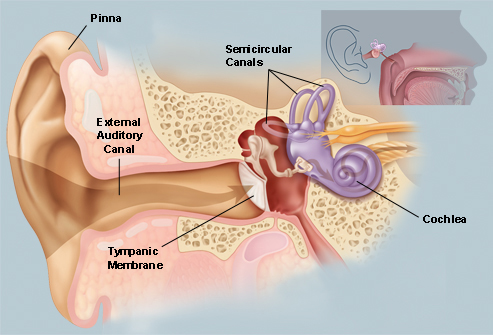The ear is divided into three areas: The outer ear, the middle ear, and the inner ear.

Outer Ear: The outer ear includes the exterior portions of the ear and the ear canal. This portion of the ear "funnels" the noise into the ear canal which acts as a resonating chamber increasing the sound level pressure, particularly at the 4000 Hz frequency range.
Middle Ear: The middle ear begins at the ear drum (tympanic membrane) and includes three small bones called the ossicular chain (i.e., the hammer-malleus, anvil-incus, and stirrup-stapes). The ossicular chain incorporates two movable parts, the round and oval windows. On either side of the bony structure is the opening to the eustachian tube and the mastoid air cells. This portion of the ear translates the sound pressure from the ear canal into the inner ear where the noise is perceived.
Inner Ear: The inner ear, filled with endolymph fluid, includes the vestibular receptive system (responsible for position) and the cochlea (responsible for hearing). The vestibular system allows for balance. The cochlea contains feather-like hair cells that vibrate (from sound pressure) at different frequencies and nerve endings within an interior complex structure called the organ of corti. Hearing is perceived and communicated to the brain in this area of the ear.
Conductive Hearing Loss
Hearing loss involving the outer or middle portions of the ear is termed conductive hearing loss. This type of hearing loss can be caused by fixation of the bones in the middle ear that prohibts their movement or interruption of the bone chain. Most conductive hearing loss occurs as a result of infection or head trauma. With conductive hearing loss the loudness of the sound is reduced due to the reduced ability of the middle ear to conduct the sound to the inner ear though the clarity is preserved because the cochlea in the inner ear is preserved.
Sensorineural Hearing Loss
Hearing loss involving the inner portion of the ear is termed sensorineural hearing loss. Sensorineural hearing loss can involve impairment of the cochlea and/or the nerves. Both loudness and clarity are affected by sensorineural hearing loss. Damage to the feather-like hair cells and/or the nerves are caused by repeated trauma to these organs when high levels of noise is encountered over a period of time. Sensorineural hearing loss is the most common in occupational and recreational settings with exposures to hazardous noise of a period of months or years. This type of hearing loss is not reversible.
For more information, see Plog & Quinlan, Fundamentals of Industrial Hygiene, 6th Edition.

